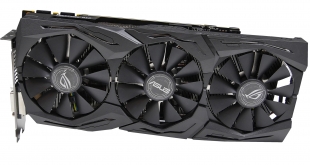
With its ROG STRIX GTX 1080 Ti OC graphics card, ASUS has taken the GTX 1080 Ti, increased its core clock by 115MHz, given it more power headroom, and slapped on a triple-fan cooler. The result of those modifications is an £800 graphics card that promises higher performance than the Founder's Edition while also operating at lower noise and temperature levels. Plus, there's RGB lighting with AURA sync to keep up with the ‘RGB-everything' trend of 2016 and 2017.
There are a few tricks to the ASUS ROG STRIX GTX 1080 Ti OC graphics card that should make it faster than the Founder's Edition. First and foremost is the factory overclock which puts the GPU core at a dizzying 1595MHz, with a 1709MHz rated boost frequency, as well as marginally bumping the GDDR5X memory up to 11,112MHz effective. A combination of the triple-fan cooler and enhanced power delivery system are to thank for the overclocked GPU core.
ASUS deploys a pair of 8-pin PCIe connectors alongside a 10+2 phase power deliver system that should help to minimise power-induced throttling in the GPU Boost 3.0 equation. Tackling the thermal challenge is a triple-fan, 2.5-slot cooler that uses a new contact plate and a thicker fin array, compared to previous STRIX cards. Finishing touches to the ROG STRIX GTX 1080 Ti OC come in the form of AURA-compatible RGB LED lighting and a pair of 4-pin fan headers that are given software-based control.
With an eye-watering £800 asking price, can the ASUS ROG STRIX GTX 1080 Ti OC prove itself to be worthy of a £100 premium over Nvidia's Founder's Edition card?
Our sample from ASUS seemed to ship with the OC Mode enabled by default (we did not install ASUS' GPU Tweak II software to manually enable it). Operating frequencies for the OC Mode are 1595MHz Core, 1709MHz Boost, and 1389MHz (11,112MHz effective) memory. The alternative – Gaming – mode drops the boost clock to 1683MHz, according to ASUS.
In gaming, we observed the stable boost core frequency loitering between 1898MHz and 1962MHz, depending on the level of loading (which proved resolution-biased) and the game being played.
Features (taken from ASUS' product page):
- NVIDIA GeForce® GTX 1080 Ti is the fastest gaming GPU that delivers 35% faster performance than the GeForce GTX 1080.
- MaxContact Technology and 2.5-Slot Width for the coolest and quietest gaming performance.
- Patented Wing-Blade Fan Design with IP5X dust-resistance for longer fan lifespan.
- ASUS FanConnect II for optimal cooling performance.
- Fan Profile Switch instantly change from high-performance to quiet operation.
- Industry Only Auto-Extreme Technology with Super Alloy Power II delivers premium quality and best reliability.
- ASUS Aura Sync for perfect RGB LED synchronisation.
- VR-friendly HDMI ports let you enjoy VR experiences anytime without having to swap cables.
- GPU Tweak II with XSplit Gamecaster provides intuitive performance tweaking and real-time streaming.
- Warranty Period – 3 Years.
Packaging for the ASUS ROG STRIX GTX 1080 Ti OC is standard for an Nvidia card delivered by ASUS. Graphics of the card itself and some of the key features are shown on the front and rear sides of the box.
A slim accessory bundle consists of two Velcro cable ties and a dual-6-pin to 8-pin PCIe power adapter. Don't use that adapter if you are buying a graphics card of this calibre; you should already own a sufficiently capable PSU before spending £800 on a GPU, plus those red and black cables will be perceived as ugly to many buyers who care about aesthetics.
The drivers CD and documentation should find a loving home inside your bin. Get the latest drivers from the Nvidia website.
A dark black colours scheme is used for the ASUS ROG STRIX GTX 1080 Ti OC graphics card. Personally, I think this is a clever idea as it allows a buyer to make use of the onboard RGB LED lighting to create a colour scheme of their choice, while the cooler shroud stays a neutral black that is easy to accompany.
Three of ASUS' patented 92mm Wing-Blade fans force air over the thick aluminium fin array. ASUS, has been marketing the ‘105% more air pressure’ point for the Wing-Blade fans since their introduction. That ‘105%' figure should certainly be taken with a grain of salt but the cambered aerofoil structure on the blades’ outer edges will indeed increase the pressure of air interacting with it.
Longevity is clearly a focus for the fan design, and so it should be for a graphics card costing the best part of a grand. The fans are IP5X-certified for dust-resistance and their 0dB operating mode reduces fatigue on the mechanical bearing. That last point also helps to reduce noise output when the GPU is operating under lower levels of load, as the fans don't start spinning until a 55°C core temperature is reached. The fans stay active below 55°C during cool down, which is a good move by ASUS.
Large is an understatement for ASUS' flagship beast. The graphics card measures in at around 30cm in length with a width of around 13cm (when installed). The sizeable dimensions don't stop there as the thickness of around 5.25cm makes this a 2.5-slot unit. Mini-ITX users may want to check their chassis before clicking the buy button, as a combination of the sheer length, 2.5-slot thickness, and wider-than-usual PCB make interference in SFF systems a strong possibility.
Weighing almost 1.3kg, this card is a perfect example for the uptake in strengthened PCIe x16 slots on modern motherboards. If you plan on shipping a system with this beast installed, I would advise caution. Thankfully, ASUS uses a custom PCB brace and a backplate which, combined with the mounting point for the heavy GPU cooler, should help to mitigate PCB sag.
An eye-catching backplate resides over the entirety of the rear PCB. This design choice, coupled with the RGB LED-capable ROG logo cut into the backplate, should tick the aesthetic box for many users.
A peek through the small gap between the backplate and PCB indicates that the metal piece is purely aesthetic. This is a little disappointing given the ability of the slab of metal to conduct heat away from power delivery components, such as the rear-mounted capacitors.
Juice is delivered via a pair of 8-pin PCIe power connectors (in addition to the PCIe slot), which provides additional headroom over the GTX 1080 Ti default 6-pin + 8-pin configuration. ASUS reverses the power connectors to make un-clipping the latches an easier task. They aren't recessed particularly far into the heatsink, either, which aids ease of installation and removal.
Two SLI fingers are found in their usual location. Both gold connectors will be used when linking a pair of cards together with a High-Bandwidth SLI bridge. Note that the additional width of the card's PCB will limit the possibility of using a different card in SLI. This is because the rigid HB SLI bridge is not flexible like the old ribbon cables and therefore partnering cards must be the same width.
Mounted at the front of the card's PCB, shrouded by the triple-fan cooler's trailing edge, are several headers. Two 4-pin PWM- and DC-capable fan headers form ASUS' FanConnect II system. These headers can be used to connect a pair of chassis fans and allow them to be controlled, using ASUS' OS-based software, based on the GPU temperature, not just the CPU (as is the case for most motherboard-based fan headers).
This is a very smart move on ASUS' part as it allows a user to set their chassis fans to ramp up while gaming, which is not always easy for PWM or DC-controlled fans that take readings from a CPU that is likely to be running significantly cooler than the GPU. In my own personal system, for example, my pair of graphics cards struggle to stay below 85°C while the overclocked CPU is happily running at around 50°C and therefore limiting how far the chassis fan speeds increase. A GPU-driven fan speed curve would aid the hot-running cards even when the CPU is operating at a significantly lower temperature. GPU temperature-based fan control at the motherboard level is generally poor or impossible so ASUS has provided a smart solution.
There is a 4-pin AURA-capable RGB LED header positioned next to the fan connections. This allows the graphics card to be connected to compatible partnering hardware and controlled using a system-wide AURA sync profile.
What's the deal with those ugly, multi-coloured cables, ASUS? They have absolutely no place on a graphics card of this calibre and with this target audience. A minor point, perhaps, but everything is amplified when the consumer is stumping up £800 for a premium graphics card.
Despite Nvidia's exclusion of the DVI connector on its Founder's Edition GTX 1080 Ti, ASUS calls old-trusty back into action. I like this move as Dual-Link DVI is still an effective way to power 1600P or 1440P 60Hz monitors without having to deal with the DisplayPort issues introduced by Windows. With a cooler that dumps most of its air inside the chassis, rather than through the rear vent, that reduction in slot ventilation area won't be missed.
Filling out the display IO is a pair of 8K-capable DisplayPort connectors (that are 1.2 certified and 1.3/1.4 ready, according to Nvidia) and two 4K60-capable HDMI 2.0b ports. That doubling on the number of HDMI 2.0 ports is ASUS' way of making the company's graphics card more VR-friendly – you can simultaneously output to a VR headset and a high-resolution HDMI monitor or TV without the need for sometimes costly DisplayPort adapters.
Conversely, a reduction in the number of DP connectors may inconvenience some users with multi-monitor setups (I have personally required three DP connectors to power a 4K and a 5K monitor, for workstation usage, in the past).
Size differences between ASUS' overclocked ROG STRIX model and the Founder's Edition GTX 1080 Ti are clearly visible. ASUS' card is longer, wider, and thicker. While those metrics combine to form what should be improved cooling potential, they also reduce compatibility for SFF users and present some multi-GPU headaches (depending on motherboard slot spacing).
The side profile of ASUS' card also makes it clear that the 250W+ of thermal energy will be dumped inside one's chassis. That's fine if you have adequate case airflow but can present challenges in a mid-tower chassis if you combine a pair of cards in SLI.
Dual-card users will be tasked with running their case fans in a way that allows them to remove over 500W worth of warm air from a relatively small section of their chassis. That's not easy when the card's heatsink design means that air is being blown against a motherboard PCB or side panel window. This is different to blower-style cards, such as the Founder's Edition, which force most of their hot air through rear exhaust vents, at the expense of noise and overall cooling performance.
Other than the sheer size of the card, one of the first points that I noticed was the flimsiness of the plastic shroud on the side and near to the rear display outputs. Picking up the card by holding its shroud (a common procedure I perform for all graphics cards I work with) resulted in flexing of the relatively feeble plastic.
While the shroud's plastic did not feel as if it would break, it certainly didn't fill me with confidence for the build quality that I would expect from an £800 piece of hardware.
ASUS' RGB LED lighting is emitted from several areas on the graphics card. Whether your chassis is configured to view the graphics card from the top, side, or bottom, there is a good amount of LED lighting on show. Being AURA compatible, a variety of lighting colours and modes are supported, including synchronisation with other AURA components.
A die-cast plate is used to cover and cool the eleven GDDR5X memory chips and the power delivery MOSFETs. Incidental airflow is deemed sufficient for cooling the plate in areas relating to the memory chips. The MOSFETs get a thermal pad and direct contact from a proportion of the fin array to aid cooling, though contact with thin-walled fins is less useful than with a plate of metal.
An additional function for the die-cast plate is structural rigidity. Acting as a brace, it screws into the rear IO bracket as well as the backplate, through various points on the PCB, to better distribute mechanical load and minimise GPU sag.
ASUS' Auto-Extreme automated manufacturing technology is used for the ROG STRIX GTX 1080 Ti OC. The solder points are visibly ‘smoother' and the PCB appears to be cleaner thanks to the use of robots in the production process.
The 10+2-phase Super Alloy Power II system, as ASUS brands its, encompasses the capacitors, chokes, and co-packaged MOSFET solutions. ‘Super‘ marketing claims aside, the electronic components are touted to offer longer lifespans and improved temperature or efficiency performance. The concrete alloy chokes help to minimise coil whine, according to ASUS, though we did not notice any inductor buzzing on our Founder's Edition GTX 1080 Ti sample.
I am very pleased to see that ASUS has finally ditched the inefficient heatpipe direct touch design and has instead utilised a contact plate on top of the GPU. This is smart because the previous design meant that outer heatpipes on a five-pipe design were barely touching the GPU core. With this new ‘MaxContact‘ copper plate, thermal energy can be removed from the GPU before being released in a controllable manner to the six heatpipes. ASUS suggests that its precision machining step reduces surface roughness of the copper plate, allowing it to make better contact with the GPU core.
ASUS' new 2.5-slot cooler uses a heatsink with 40% more surface area, compared to the previous 2-slot design. Six heatpipes are used to transfer thermal energy away from the copper baseplate, three of which wrap around into the fin array above the GPU core. Little tricks, such as extending the fin array either side of protruding capacitors, are deployed for ASUS to hit its 40% increase in surface area.
Our GPU test procedure has been built with the intention of benchmarking high-end graphics cards. We test at 1920×1080 (1080p), 2560×1440 (1440p), and 3840×2160 (4K UHD) resolutions.
We try to test using the DX12 API if titles offer support. This gives us an interpretation into the graphics card performance hierarchy in the present time and the near future, when DX12 becomes more prevalent. After all, graphics cards of this expense may stay in a gamer's system for a number of product generations/years before being upgraded.
General Test System Notes
- AMD Graphics cards were benchmarked with the AMD Crimson Display Driver 16.11.4.
- Nvidia Graphics cards were benchmarked with the Nvidia Forceware 375.70 driver.
- The Nvidia GTX 1080 Ti cards are benchmarked with a new Nvidia Forceware 378.78 driver to support the new card.
Test System
| CPU |
Intel Core i7 6700K ‘Skylake' (Retail)
Overclocked to 4.4GHz Core, 4.4GHz Cache |
| Motherboard |
ASUS Maximus VIII Hero
|
| Memory |
G.Skill Trident Z
16GB (2x8GB) @ 3000MHz 16-18-18-38-2T |
| Graphics Card |
Varies
|
| System Drive |
Micron M600 256GB SATA 6Gbps SSD
|
| Games Drive | SK hynix SE3010 960GB SATA 6Gbps SSD |
| Chassis | NZXT Phantom 630 (medium fan speed) |
| CPU Cooler |
Corsair H110i GT
|
| Power Supply |
Seasonic SS-760XP 760W Platinum
|
| Operating System |
Windows 10 Professional with Anniversary Update (64-bit)
|
Our test system consists of an overclocked Core i7-6700K processor and 16GB of 3000MHz G.Skill DDR4. High-end hardware is used to eliminate CPU and memory from the bottleneck equation and put the performance onus solely on the GPU being tested.
Comparison Graphics Cards List
- AMD RX 480 8GB Reference (1266MHz core / 2000MHz memory)
- AMD R9 Fury X (1,050MHz core / 500MHz memory)
- Nvidia GTX 1080 Ti (1480MHz core / 1582MHz Boost / 1376MHz memory)
- Nvidia GTX Titan X (Pascal) (1418MHz core / 1531MHz Boost / 1251MHz memory)
- Gigabyte GTX 1080 G1 Gaming (1696MHz core/ 1835MHz Boost / 1251MHz memory)
- ASUS ROG STRIX GTX 1080 Gaming A8G (1671MHz core/ 1810MHz Boost / 1251MHz memory)
- Nvidia GTX 1080 Founders Edition (1607MHz core/ 1734MHz boost / 1251MHz memory)
- PNY GTX 1070 XLR8 OC (1607MHz core/ 1797MHz boost / 2002MHz memory)
- Nvidia GTX 1070 Founders Edition (1506MHz core/ 1683MHz boost / 2002MHz memory)
- Nvidia GTX Titan X (Maxwell) (1,000MHz core / 1,753MHz memory)
- Gigabyte GTX 980 Ti XTREME Gaming (1216MHz core / 1800MHz memory)
- Nvidia GTX 980 Ti Reference (1000MHz core / 1,753MHz memory)
Software and Games List
- 3DMark Fire Strike & Fire Strike Ultra (DX11 Synthetic)
- 3DMark Time Spy (DX12 Synthetic)
- VRMark Blue Room (Synthetic)
- Unigine Heaven (DX11 Synthetic)
- Ashes of the Singularity (DX12)
- Deus Ex: Mankind Divided (DX12)
- Gears of War 4 (DX12)
- Grand Theft Auto V (DX11)
- Metro Last Light Redux (DX11)
- Rise of the Tomb Raider (DX12)
- The Witcher 3: Wild Hunt (DX11)
- Total War: Warhammer (DX12)
3DMark Fire Strike is a showcase DirectX 11 benchmark designed for today's high-performance gaming PCs. It is our [FutureMark's] most ambitious and technical benchmark ever, featuring real-time graphics rendered with detail and complexity far beyond what is found in other benchmarks and games today.
ASUS' overclocked GTX 1080 Ti makes a strong start in the set of 3DMark tests. Chart-topping scores are delivered for the Fire Strike runs, as well as Time Spy.
The ROG STRIX GTX 1080 Ti OC card's lead over a FE GTX 1080 Ti is 6.6% in 3DMark Fire Strike Ultra and 7.1% in Time Spy. Compared to a reference GTX 980 Ti from yesteryear, the ASUS card offers almost double the score in the DX12 Time Spy test.
Futuremark's new VRMark benchmark is the latest addition to our test suite. The recently-released benchmark aims to score GPUs based on their VR performance potential by using rendering resolutions associated with VR devices of today and the future.
The Blue Room test, and its 5120×2880 rendering resolution, is an absolute killer for graphics cards but it does show tangible gains when stepping up through the performance hierarchies.
VRMark's Blue Room test also sees the factory-overclocked ASUS GTX 1080 Ti sitting comfortably at the top of our chart. A performance improvement of 7.7% over the GTX 1080 Ti FE card is provided by ASUS' overclocked configuration and strong cooler.
Unigine provides an interesting way to test hardware. It can be easily adapted to various projects due to its elaborated software design and flexible toolset. A lot of their customers claim that they have never seen such extremely-effective code, which is so easy to understand.
Heaven Benchmark is a DirectX 11 GPU benchmark based on advanced Unigine engine from Unigine Corp. It reveals the enchanting magic of floating islands with a tiny village hidden in the cloudy skies. Interactive mode provides emerging experience of exploring the intricate world of steampunk. Efficient and well-architected framework makes Unigine highly scalable:
- Multiple API (DirectX 9 / DirectX 10 / DirectX 11 / OpenGL) render
- Cross-platform: MS Windows (XP, Vista, Windows 7) / Linux
- Full support of 32bit and 64bit systems
- Multicore CPU support
- Little / big endian support (ready for game consoles)
- Powerful C++ API
- Comprehensive performance profiling system
- Flexible XML-based data structures
We set Quality to ‘Ultra’, Tessellation to ‘disabled’, Anti-Aliasing to 2x and the resolution to 2560×1440 (1440p).
Seeing the pattern yet? Another chart-topping display by the ASUS ROG STRIX card with its performance increase over the GTX 1080 Ti Founder's Edition competitor being 6.7%. This improvement is heavily related to ASUS' stronger cooling solution which minimises thermally-induced core frequency throttling, unlike the Founder's Edition card.
Ashes of the Singularity is a real-time strategy game set in the future where descendants of humans (called Post- Humans) and a powerful artificial intelligence (called the Substrate) fight a war for control of a resource known as Turinium.
Players will engage in massive-scale land/air battles by commanding entire armies of their own design. Each game takes place on one area of a planet, with each player starting with a home base (known as a Nexus) and a single construction unit.
We opt for the Extreme quality profile and run the GPU-Focused test using the DX12 game mode.
Note: 4K data showed a performance change likely due to a game update. As such, we removed invalid data and re-tested the Titan X (Pascal) to compare against the GTX 1080 Ti FE. The differences at 1440P and 1080P were within margin of error of the test procedure and therefore the previously gathered data remains.
A clean-sweep of chart-topping displays by the ASUS ROG STRIX GTX 1080 Ti OC in Ashes of the Singularity. At 1440p, the ASUS card is 2.2% faster than the Founder's Edition. That lead increases to 3.7% at 4K.
Clock speed for the ASUS card was generally around 1936-1962MHz, with fluctuations above and below, throughout the 4K benchmark run.
Deus Ex: Mankind Divided is set in the year 2029, two years after the events of Human Revolution and the “Aug Incident”—an event in which mechanically augmented humans became uncontrollable and lethally violent.
Unbeknownst to the public, the affected augmented received implanted technology designed to control them by the shadowy Illuminati, which is abused by a rogue member of the group to discredit augmentations completely. (Wikipedia).
We test using the Ultra quality preset at 1080p and 1440p. The Very High preset was used for 4K. We used the DirectX 12 API.
Deus Ex: Mankind Divided pins the ASUS card in top place for all tested resolutions. On average, ASUS' factory-overclocked, custom-cooled board is 5.5% faster than the GTX 1080 Ti FE at 1440P and 5.7% better at 4K.
A clock speed of 1949MHz seemed to be constant throughout the 4K benchmark run, with very few fluctuations above or below that level.
The Gears Of War 4 game’s plot is set 25 years after Gears of War 3 and focuses on JD Fenix, the son of Marcus Fenix. Gears of War is a third-person shooter game, with its core concepts being derived from Resident Evil 4‘s “over the shoulder” perspective, Kill Switch‘s cover system, and Bionic Commando‘s swinging action akin to moving between points of cover. (Wikipedia).
Gears of War 4 is launched via the Windows 10 Store, requires the Windows 10 Anniversary Update to run, and only supports the DirectX 12 API.
We test using the Ultra quality preset. Dynamic Resolution scaling was turned off and Async Compute was enabled where the GPU supported it.
CPU-induced bottlenecking on our 4.4GHz Skylake Core i7-6700K has an influence on the 1080P results, hence ASUS' drop to third place in terms of average frame rate.
Focussing instead on the higher-resolution results, ASUS' ROG STRIX GTX 1080 Ti OC takes first place by a comfortable margin. At 1440P, ASUS' overclocked card is 6.7% faster on average than the Founder's Edition. The ROG STRIX board's average lead over the FE card at 4K is 6.5%. Minimums are also improved on the ASUS ROG STRIX GTX 1080 Ti thanks to its higher clock speeds and improved cooling solution that helps to maintain them.
Gears of War 4 is one of the more demanding games in our test suite. At 4K, the ASUS card's core clock sat at around 1898MHz through the benchmark run.
Grand Theft Auto V is an action-adventure game played from either a first-person or third-person view. Players complete missions—linear scenarios with set objectives—to progress through the story. Outside of missions, players may freely roam the open world.
Composed of the San Andreas open countryside area and the fictional city of Los Santos, the world is much larger in area than earlier entries in the series. It may be fully explored after the game’s beginning without restriction, although story progress unlocks more gameplay content.
We use the Ultra quality settings (or the highest alternative – generally Very High or High – when Ultra is unavailable). MSAA is set to 2x for 1080p and 1440p and is disabled for 4K. The Advanced Graphics options are all set to their maximum levels.
At 1080p the game suggests 3469MB of VRAM usage. At 1440p that number increases to 3764MB. At 4K the video memory usage is quoted as 4171MB.
A reduction in CPU-induced limitations at 4K sees the ASUS GTX 1080 Ti comfortably pulling into first place for GTA V. With an average frame rate of 77 FPS, GTA V is playable at 4K with a single GTX 1080 Ti and maximum settings, even if there are dips at certain points. ASUS' overclocked ROG STRIX model is 3.8% faster than the Founder's Edition card, on average, at 4K.
Our recordings show a pretty much constant core frequency of 1949MHz throughout the GTA V benchmark runs at 4K for the ASUS card.
Just like the original game Metro 2033, Metro: Last Light is played from the perspective of Artyom, the player-character. The story takes place in post-apocalyptic Moscow, mostly inside the metro system, but occasionally missions bring the player above ground. Metro: Last Light takes place one year after the events of Metro 2033, following the canonical ending in which Artyom chose to proceed with the missile strike against the Dark Ones (this happens regardless of your actions in the first game). Redux adds all the DLC and graphical improvements.
At 1080p and 1440p, we test using a Very High quality profile with SSAA enabled and Tessellation set to Normal. At 4K we drop the quality profile down to High and disable SSAA.
Worth noting is that minimum FPS numbers for this game should be interpreted with caution as they tend to show high levels of variance between benchmark runs.
More first-place finishes for the custom-cooled ASUS GTX 1080 Ti in Metro: Last Light Redux. At 1440P, ASUS' card is 6.9% faster than the FE competitor, on average. The lead for ASUS' ROG STRIX model is 4% at 4K.
Core frequency of the ASUS card hovered in the 19xxMHz range at 4K throughout the benchmark runs. The clock speed was stable in the mid-1900s until points of more significant load were reached in the benchmark and it would start to fluctuate (driven by the voltage limit for GPU Boost 3.0).
Rise of the Tomb Raider is a third-person action-adventure game that features similar gameplay found in 2013’s Tomb Raider. Players control Lara Croft through various environments, battling enemies, and completing puzzle platforming sections, while using improvised weapons and gadgets in order to progress through the story.
It uses a Direct X 12 capable engine.
At 1080p and 1440p, we use the Very High quality preset and 2x SSAA. At 4K we disable AA completely. The DirectX 12 API is used. Numbers are taken from the benchmark's Geothermal Valley test.
Strong showings in Tomb Raider for the triple-fan cooled GTX 1080 Ti. ASUS' card manages to push past the magic 60FPS average at 4K and outperforms the FE card by 5.9% in the process.
Like Gears of War 4, Rise of the Tomb Raider's DX12 benchmark was more taxing on maximum GPU core frequency at 4K. Our logs show that the ASUS card would generally sit around 1898MHz, which was driven by a combination of limiting functions in the GPU Boost 3.0 equation. Just shy of 1900MHz out-of-the-box is certainly nothing to groan about, though.
The Witcher 3: Wild Hunt concludes the story of the witcher Geralt of Rivia, whose story to date has been covered in the previous titles. Continuing from The Witcher 2, Geralt seeks to move on with his own life, embarking on a new and personal mission while the world order itself is coming to a change. (Wikipedia).
We use the Ultra preset for general image quality, but disable the Nvidia HairWorks settings where possible. The post-processing preset is set to High. We benchmark a 107-second run through a densely-populated area of the game.
The Witcher 3 gives a trio of top-place finishes to ASUS' factory-overclocked card. At 1440P, the ASUS ROG STRIX model is 5.3% faster than a Founder's Edition, on average. That lead is 7.2% at 4K, showing that ASUS' power delivery and cooling solutions are proficient at maintaining a high boost frequency.
Core frequency throughout our benchmark runs at 4K fluctuated in the 19xxMHz region. We generally observed core frequencies between 1900-1950MHz towards the end of the 4K test run. The GPU Boost 3.0 power limit was a factor for this core frequency result.
Total War: Warhammer is a turn-based strategy game with real-time tactical battles between armies. While previous Total War games feature historical settings, Warhammer introduces a fantasy setting as well as characters from the Warhammer universe. These characters, which include monsters, warriors, and heroes, can be controlled by the player. (Wikipedia)
We set the image quality options all to Ultra. At 1080p and 1440p, AA is set to 2x but it is disabled for 4K testing. The DirectX 12 API is used.
Total War: Warhammer shows tighter grouping between the GTX 1080 Ti solutions until the 4K test resolution. At 1440P, the ASUS ROG STRIX and Nvidia Founder's Edition GTX 1080 Ti solutions are practically equivalent. Increasing the resolution to eight Megapixels sees ASUS' card pull ahead by 4.1%.
Core frequency for the 4K benchmark runs on ASUS' card tended to sit at a constant 1962MHz or 1974MHz. This was purely voltage limited in the GPU Boost 3.0 equation.
We first measure power while the card is sat idling at the Windows 10 desktop for 5 minutes. Gaming power draw is recorded by running Unigine Heaven DX11 benchmark for 5 minutes. As a maximum stress test, Furmark is run for 5 minutes and the cards' power draw levels are recorded.
Power draw is, unsurprisingly, high given the use of a 250W-rated GPU that is overclocked further. You'll want a high-quality power supply to partner the ROG STRIX GTX 1080 Ti OC and if you have pockets deep enough for a couple of cards in SLI, a wise PSU capacity is likely to be heading towards 850W+.
ASUS' card consumes around 20W (around 6-7%) more power than a GTX 1080 Ti Founder's Edition in our Unigine Heaven test. It also delivers better performance, so we doubt that enthusiasts will care about the running cost equivalent to a pair of energy efficient light bulbs being added to their electricity bill.
We first measure GPU temperature while the card is sat idling at the Windows 10 desktop for 5 minutes. Gaming GPU temperature is recorded by running Unigine Heaven DX11 benchmark for 5 minutes. As a maximum stress test, Furmark is run for 5 minutes and the cards' GPU temperature levels are recorded.
Ambient room temperature was held at around 19-20°C.
Cooling performance from ASUS' 2.5-slot, triple-fan design is simply superb. We struggled to push the GPU temperature past 65°C throughout our testing. Under full load, ASUS' card operates almost 20°C cooler than the GTX 1080 Ti Founder's Edition while also running at a faster core frequency.
Even with the fan speed level at around 37% during the gaming load, there is plenty of headroom to the default severe thermal throttling point of 84°C.
Thermal imaging shows the backplate doing a decent job at spreading heat, despite not being in direct contact with rear-mounted electronic components. There are no distinct hot zones that look like they could cause issues if in contact with a plastic cable or similar object.
The power delivery components mounted on the rear of the PCB were the hottest sections of the card. A cut-out in the backplate allows them to receive incidental airflow for cooling. It would have been smarter for ASUS to cover these with the backplate and use the large slab of metal to cool them.
Noise output of the graphics card is measured using the fan speed percentage associated with each of the temperature recordings displayed on the previous page.
In order to focus solely on the noise output by the graphics card in question, we disconnect all fans from the test system so that the only moving parts are the Corsair H110i GT's pump and any components relating to the graphics card.
The NZXT Phantom 630's side panel is removed in order for us to focus specifically on the graphics card's noise emissions. We also place the acoustic measurement equipment very close to the graphics card (around 10 cm away from it) in order to better detect noise differences between each graphics card. This is also a scenario that will be similar to a user who has their system sat on the desk directly next to where they are sitting.
The background noise level sits around 37-38 dBA without the test computer running.
As was the case for thermal performance, noise emission results for ASUS' triple-fan cooler are superb. ASUS' card is noticeably quieter than the GTX 1080 Ti Founder's Edition when running a game. At 33% fan speed (the Furmark level), the STRIX cooler was hard to distinguish above the background noise of our Corsair H110i GT AIO's pump.
If you have an AIO liquid cooler with high-speed fans installed in your system, it is unlikely that the ASUS ROG STRIX GTX 1080 Ti will be audible over it when running a game. Our sample card exhibited no coil whine whatsoever.
Our best overclocking result gave a +85MHz increase to the GPU Core frequency and +450MHz (+0.9GHz effective) for the GDDR5X VRAM. To achieve these values, we increased the board's allowable power delivery by 20% and set a higher fan speed to eliminate thermal throttling (though our 67% value was far higher than necessary).
Our overclocking result for ASUS' ROG STRIX GTX 1080 Ti OC was noticeably better than what we achieved with the Founder's Edition board. This seems to be a direct result of the improved power delivery solution for ASUS' card, as well as the vastly superior cooler.
The core frequency was practically locked at 2050MHz throughout our testing with multiple runs of the Gears of War 4 and Rise of the Tomb Raider benchmarks at 4K, in addition to the 4K 3DMark Fire Strike Ultra test. As confirmed by ten runs of the Fire Strike Ultra Stress Test, the card was perfectly happy with its 2050MHz operating core frequency and 12GHz GDDR5X VRAM.
MSI Afterburner reported the voltage limit as the general reason for ASUS' ROG STRIX GTX 1080 Ti sitting at 2050MHz core frequency. Voltage mod to the BIOS, anyone?
Performance boosts for our overclocked results were sizeable, even over the already-overclocked ROG STRIX GTX 1080 Ti OC in its out-of-the-box form. Our 3DMark Fire Strike Ultra score was 6.2% higher (13.2% versus stock GTX 1080 Ti FE), Gears of War 4 was 6.9% faster (13.9% versus stock GTX 1080 Ti FE), and Rise of the Tomb Raider performed 8.2% better (14.6% versus stock GTX 1080 Ti FE).
If you are interested in seeing how these results compare to the overclocked GTX 1080 Ti Founder's Edition, the figures on THIS PAGE are directly comparable. Compared to our overclocked GTX 1080 FE configuration, ASUS' manually-tuned ROG STRIX GTX 1080 Ti OC is 3.8% better in 3DMark Fire Strike Ultra, 3.5% better in Gears of War 4, and 5.4% better in Rise of the Tomb Raider.
The ASUS ROG STRIX GTX 1080 Ti OC (O11G) is a gaming powerhouse in every sense of the term. The factory-overclocked, triple-fan-cooled graphics card powers through 1440P and 4K gaming with strong results and does so while offering a performance improvement and quieter, lower-temperature operation compared to the GTX 1080 Ti Founder's Edition.
Overclocking results for the card were superb, thanks in large to ASUS' application of a 10+2 phase power delivery system with strong ‘Super Alloy Power II‘ components and dual 8-pin PCIe connectors. We added 85MHz to the already highly-overclocked GP102 core which allowed GPU Boost 3.0 to keep the ROG STRIX graphics card operating at a stable 2050MHz core frequency throughout our 4K tests. Memory frequency was also pushed to 12,000MHz effective, which is a solid gain for the 11GB of GDDR5X VRAM.
ASUS' triple-fan, 2.5-slot cooler delivers superb thermal performance whilst also remaining quiet under heavy load. We struggled to push the GPU core temperature past 65°C using the default fan speed curve which saw the speed percentage sitting at 37%. The 0dB mode worked without issue and even when tasked with a FurMark stress test, the card was less audible than the pump unit on our Corsair AIO. ASUS' card was almost 20°C cooler than the Founder's Edition, while also being significantly quieter and faster. An honourable return for a £100 premium.
It is, however, worth noting that the open design of ASUS' cooler means that most of that 250W+ of thermal energy will be released inside one's chassis. While this is unlikely to cause trouble for single-card users, it will cause an increase in the temperatures of surrounding components, such as an M.2 SSD installed beneath the card as well as the CPU, depending on its cooling method. It also places an emphasis on the performance of chassis fans that are tasked with removing the heated air. These compromises are worthwhile given the superb performance capability of ASUS' cooler.
Unsurprisingly, power consumption for ASUS' factory-overclocked board was higher than that of the Founder's Edition card. We'd wager that gamers interested in buying this calibre of graphics card will not care about an additional twenty-or-so Watts going onto their power bill.
Size is both a strength and weakness for the ASUS ROG STRIX GTX 1080 Ti OC graphics card. On the positive side, the added heatsink volume permitted by the 2.5-slot design delivers impressive thermal performance. However, the sheer size of the card in all three dimensions will limit its applicability to some enthusiast Mini-ITX gamers and SLI challenges are also likely to be experienced. It's hard to argue that the added cooler dimensions aren't worth it, based on the thermal and overclocking performance. It's also easy to see that they will cause issues for some potential buyers.
Features such as AURA-compatible RGB LED lighting and a pair of software-controllable 4-pin fan headers sweeten the deal on what is a superb graphics card, even at the lofty asking price of £800. ASUS' ROG STRIX GTX 1080 Ti OC (O11G) graphics card is highly recommended and worthy of its asking price. I will be sad to return my sample.
The ASUS ROG STRIX GTX 1080 Ti OC (O11G) 11GB graphics card is available to purchase from Overclockers UK for £809.99 (at the time of writing).
Discuss on our Facebook page HERE.
Pros:
- Highly-overclocked out-of-the-box.
- Superb overclocking potential displayed on our sample – 2050MHz and 12GHz GDDR5X.
- Strong cooling performance.
- Excellent acoustic results.
- AURA-compatible RGB lighting and 4-pin header.
- Software-controllable 4-pin fan headers are smart.
- Two HDMI ports are good for VR gamers.
Cons:
- Plastic shroud is flimsy in places.
- 2.5-slot design will cause issues for some users.
- Backplate is primarily aesthetic and does not provide conductive cooling.
KitGuru says: A superb graphics card with a well-designed cooler and strong overclocking potential. Worthy of its £800 asking price.
 KitGuru KitGuru.net – Tech News | Hardware News | Hardware Reviews | IOS | Mobile | Gaming | Graphics Cards
KitGuru KitGuru.net – Tech News | Hardware News | Hardware Reviews | IOS | Mobile | Gaming | Graphics Cards


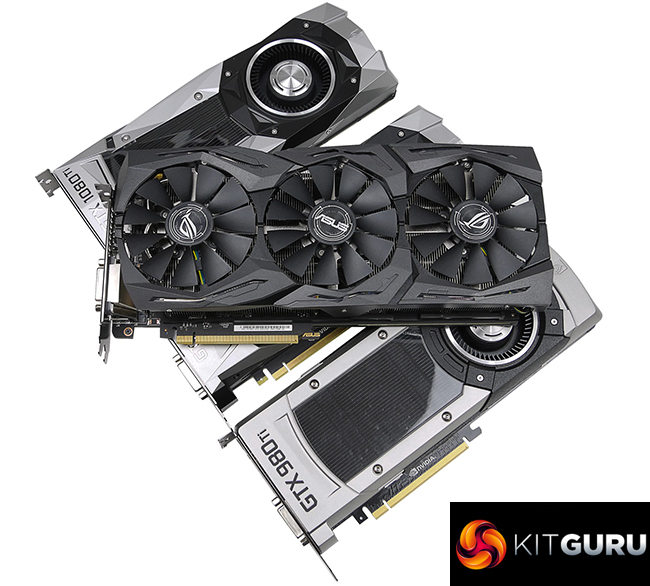
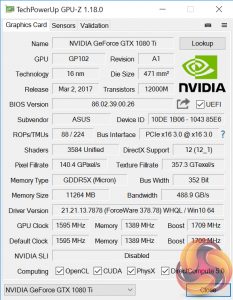




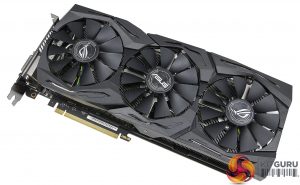
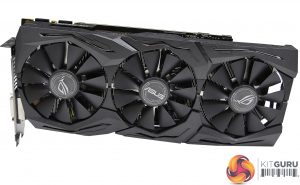
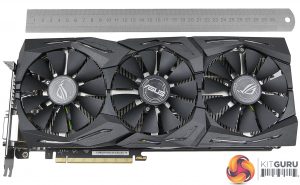
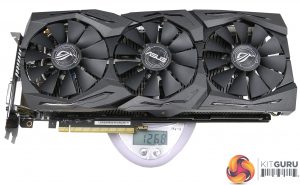
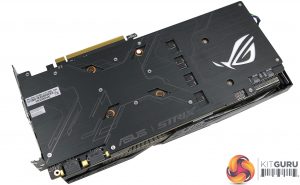
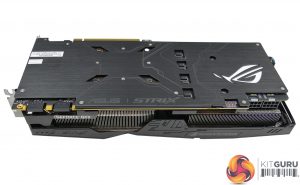
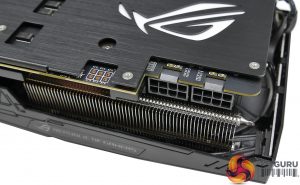
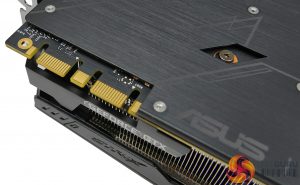
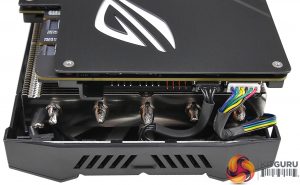
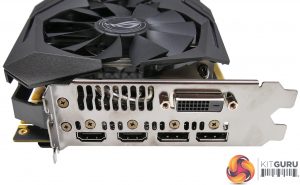
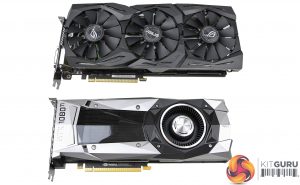
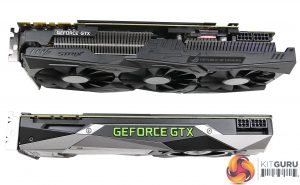

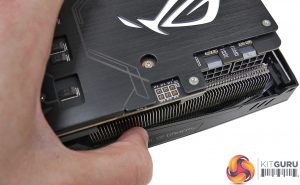
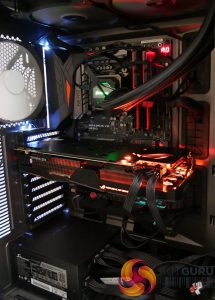

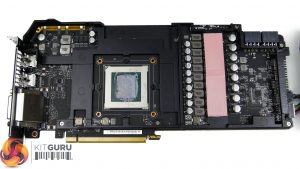
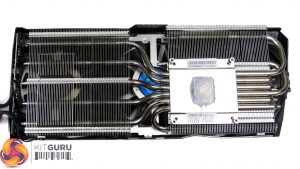
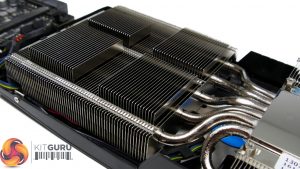
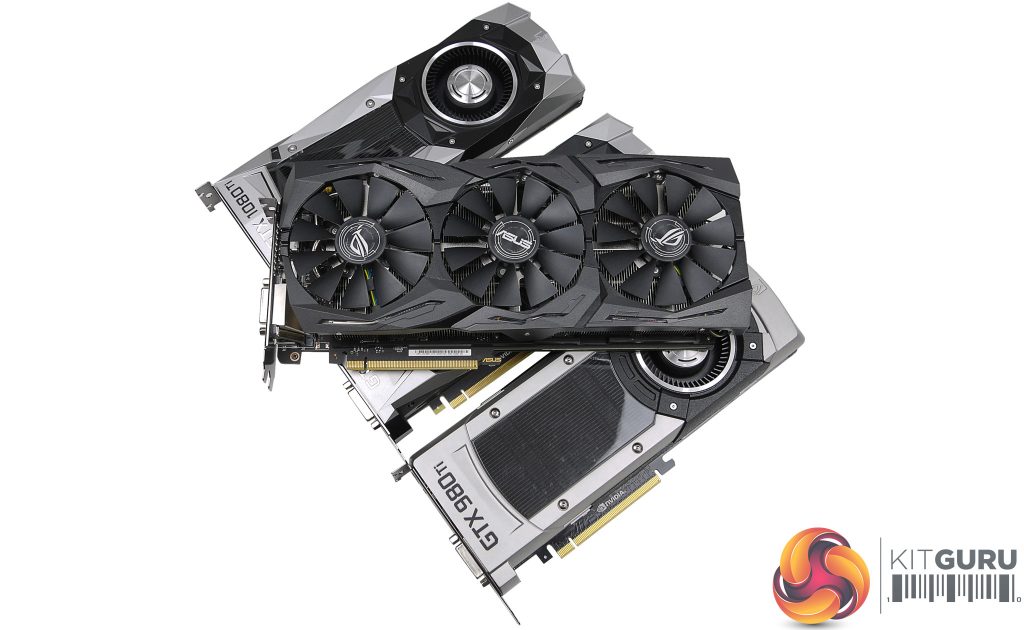
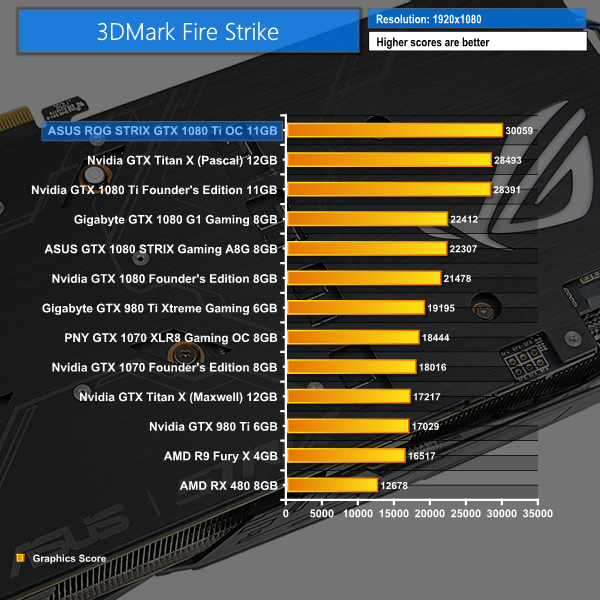
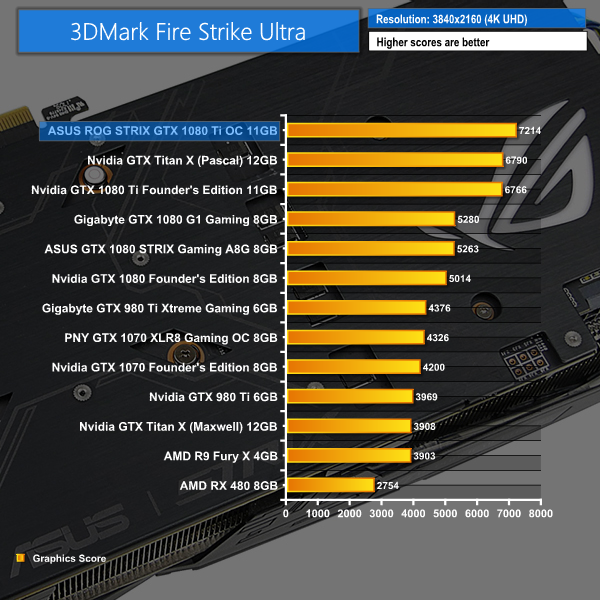



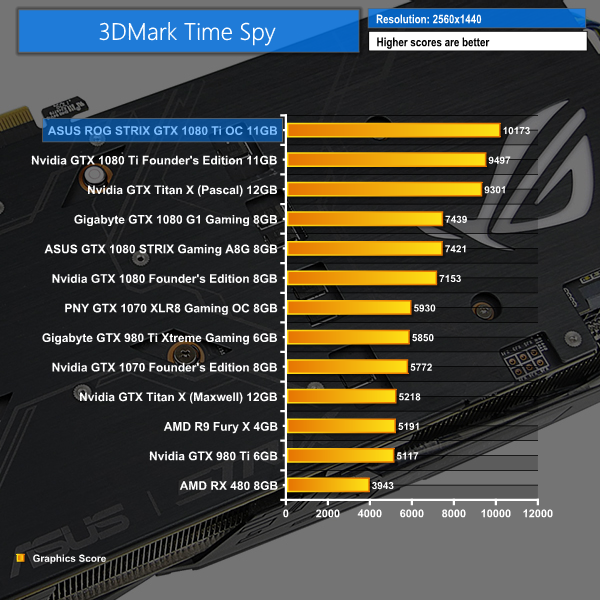

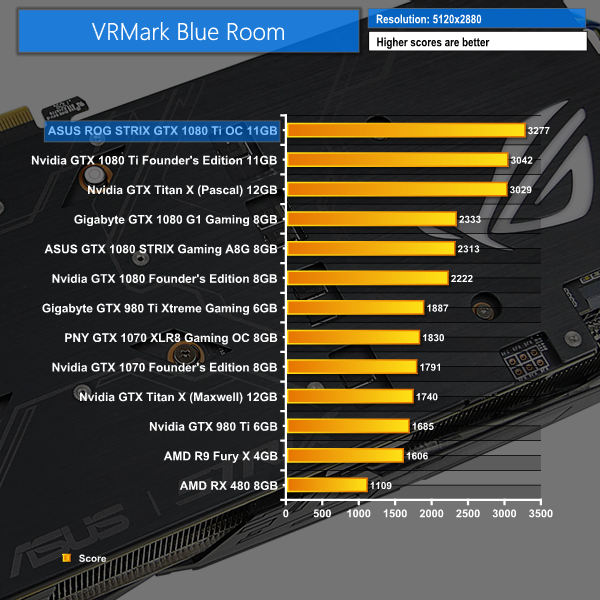


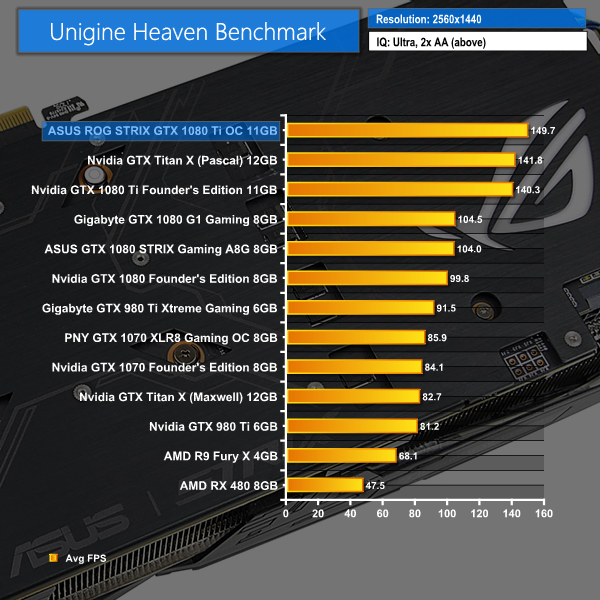



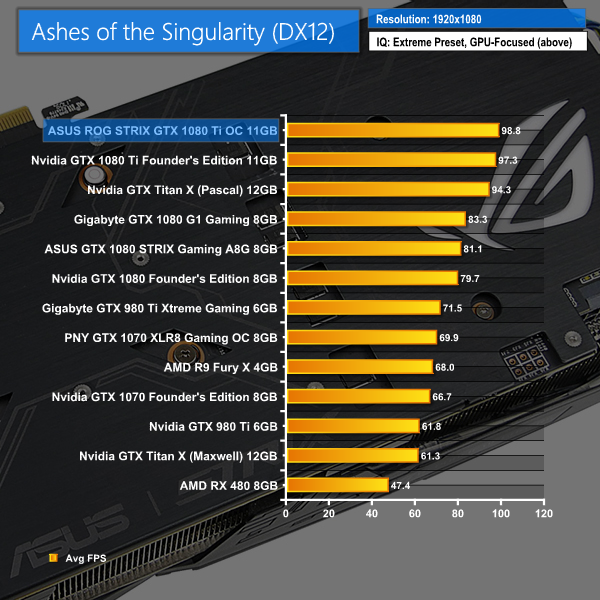
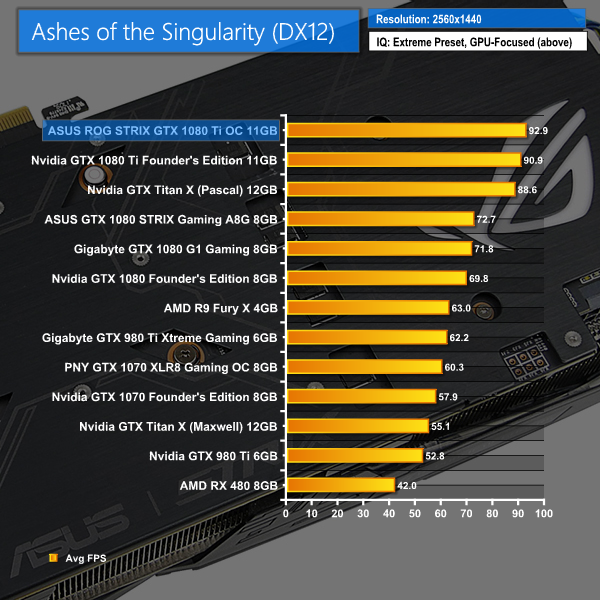
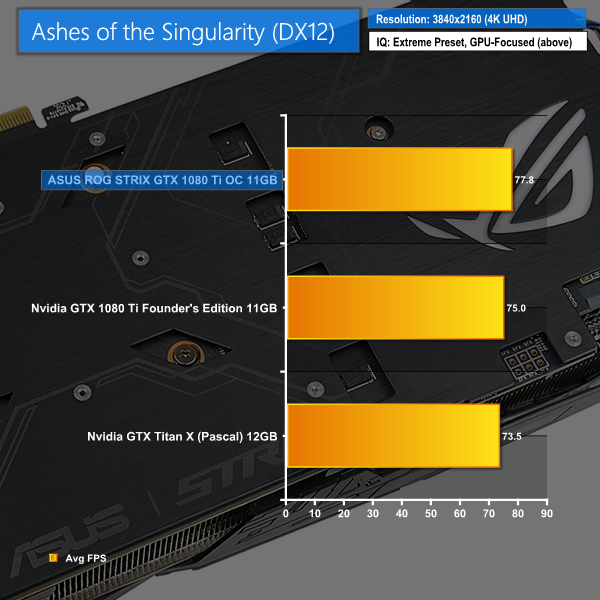


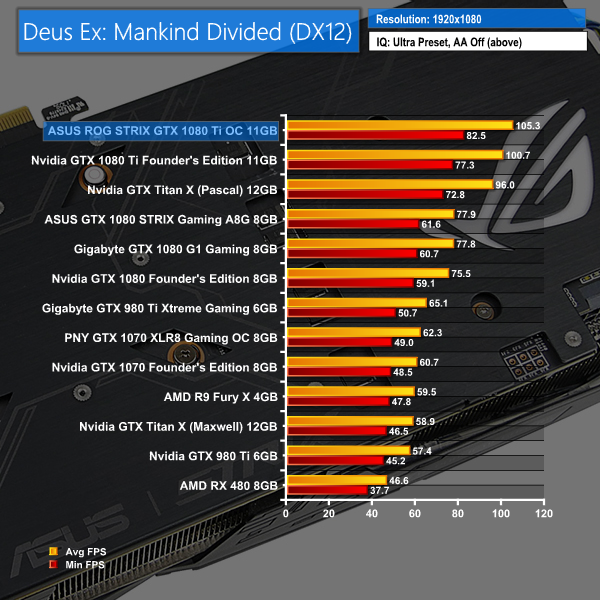
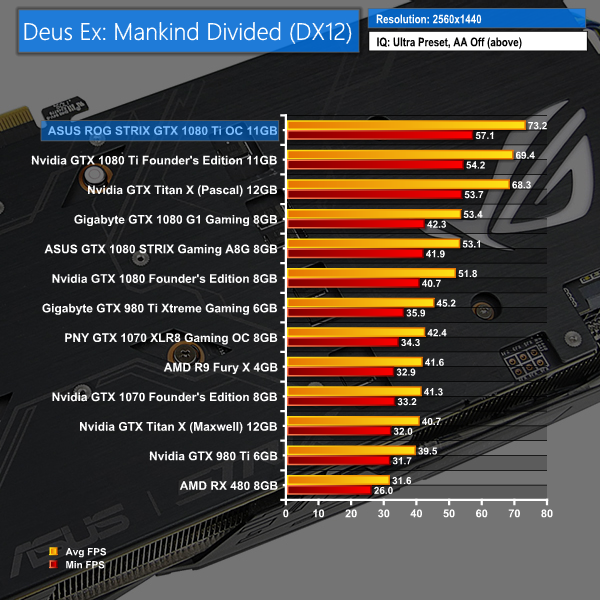
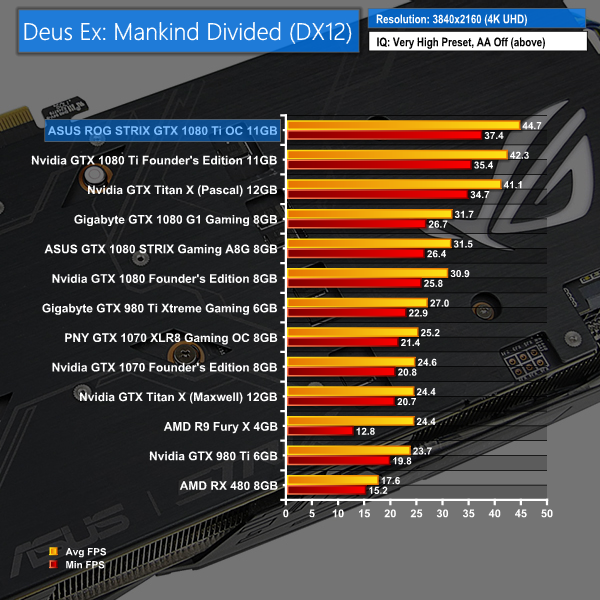




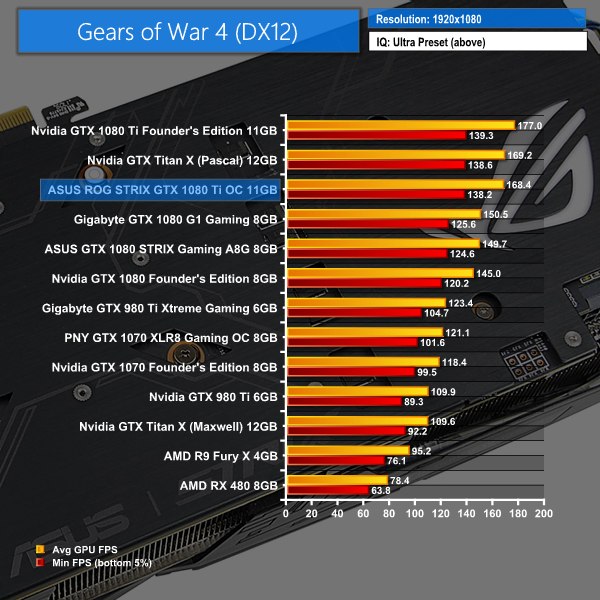
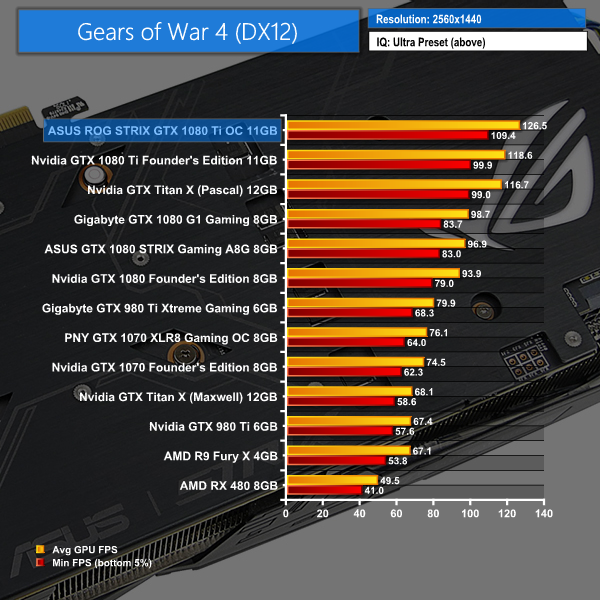
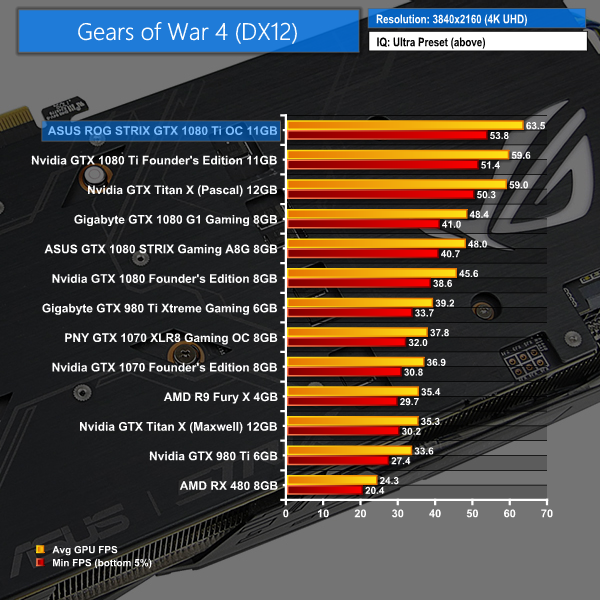




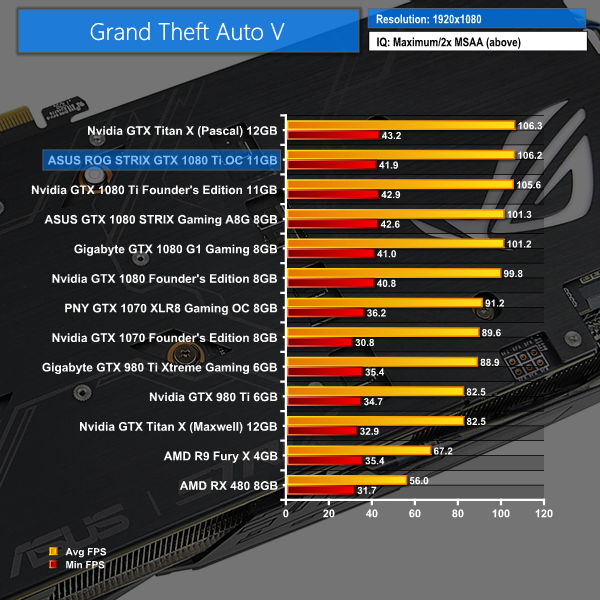
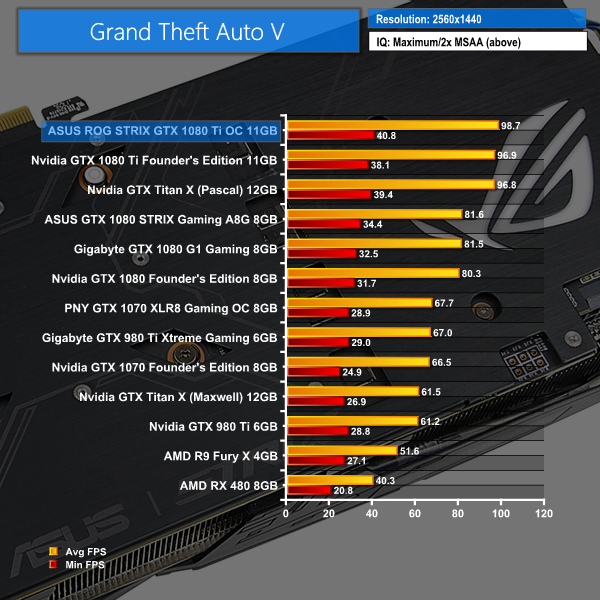
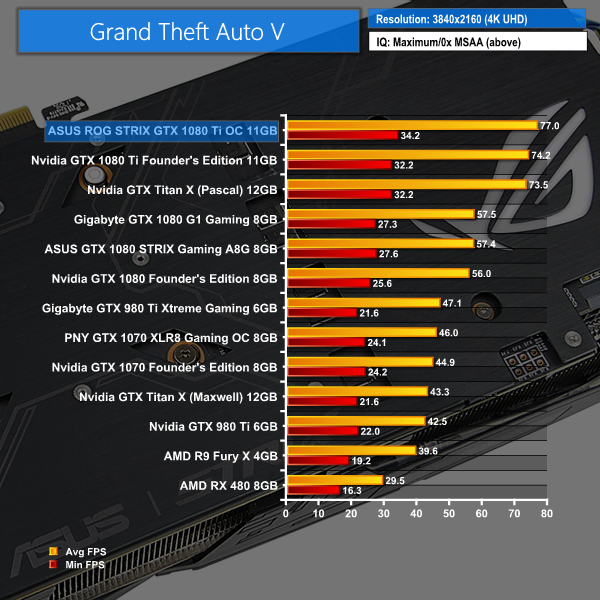


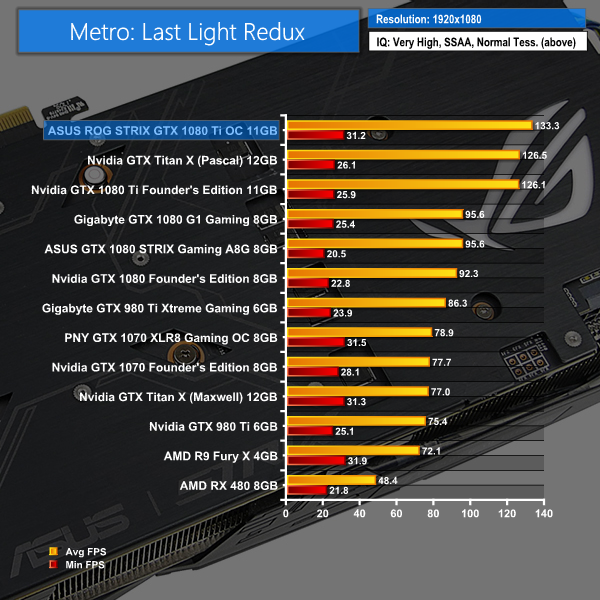
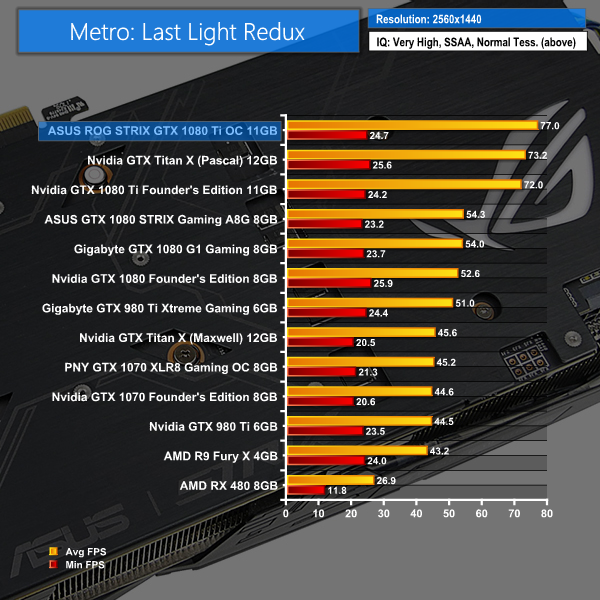
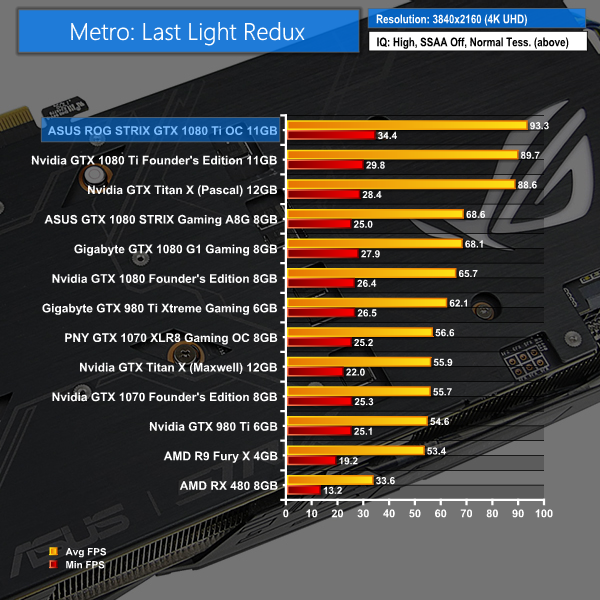


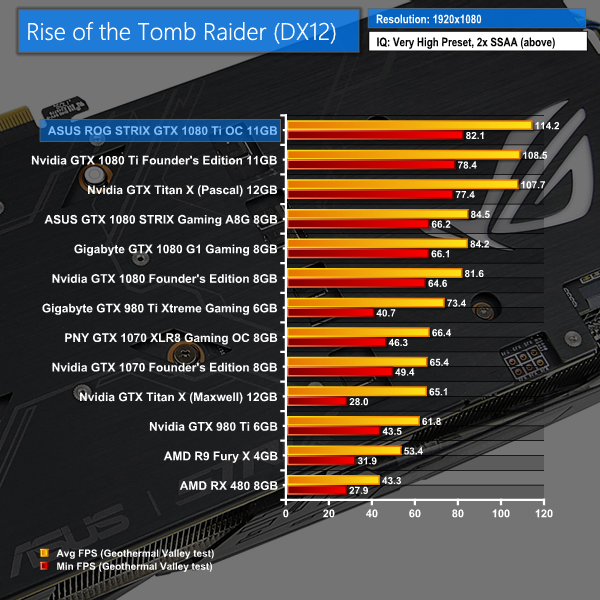
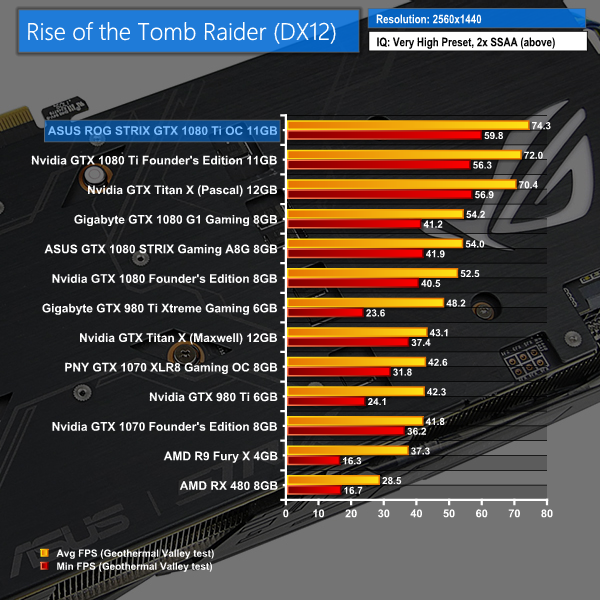
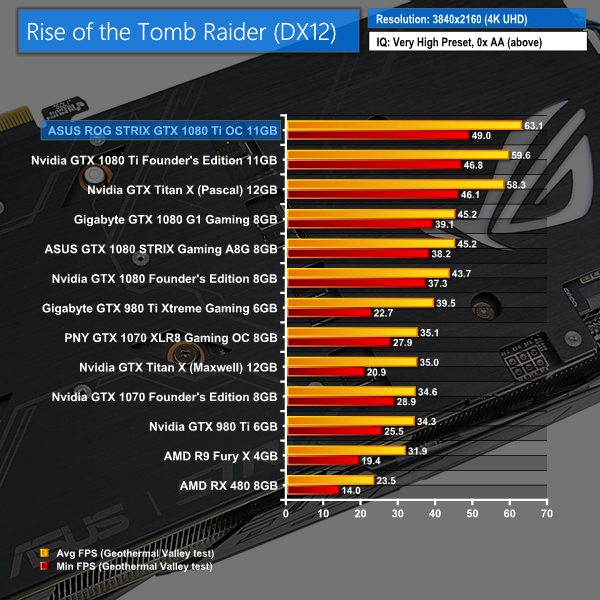



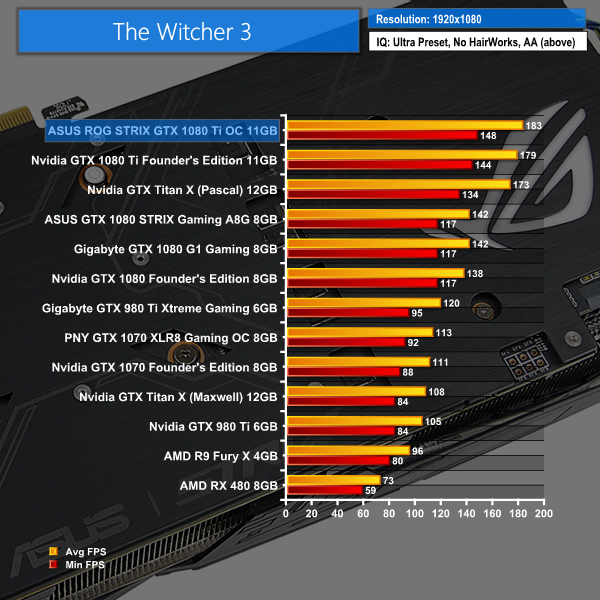
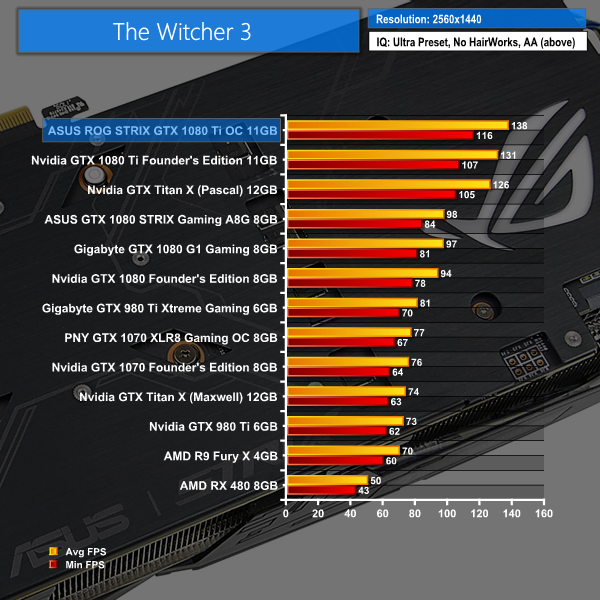
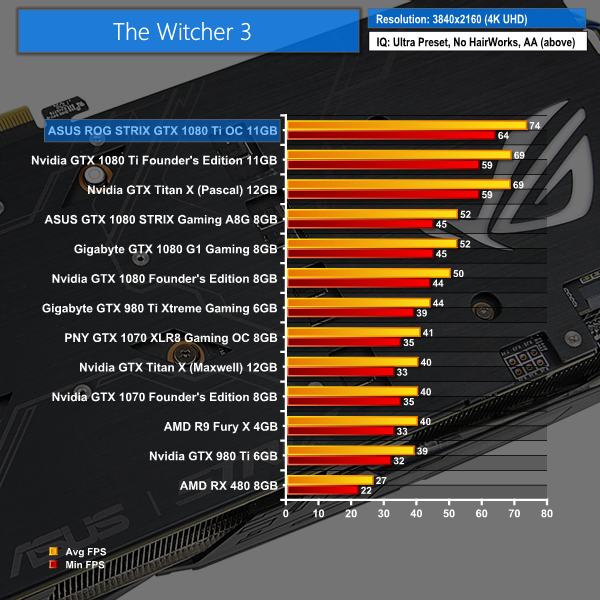

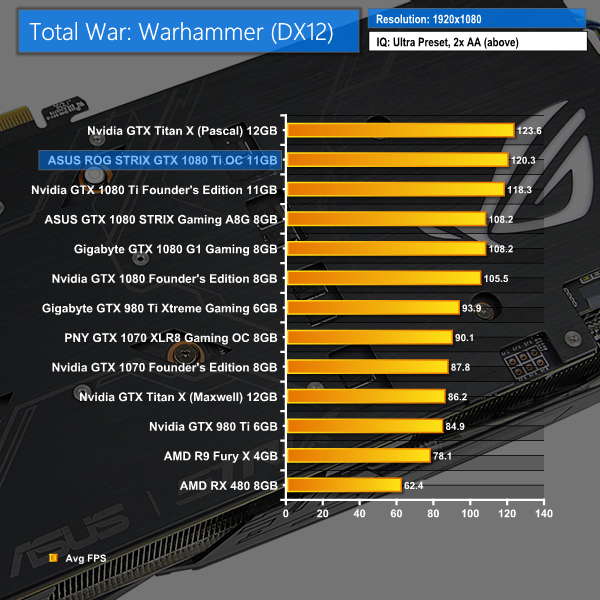
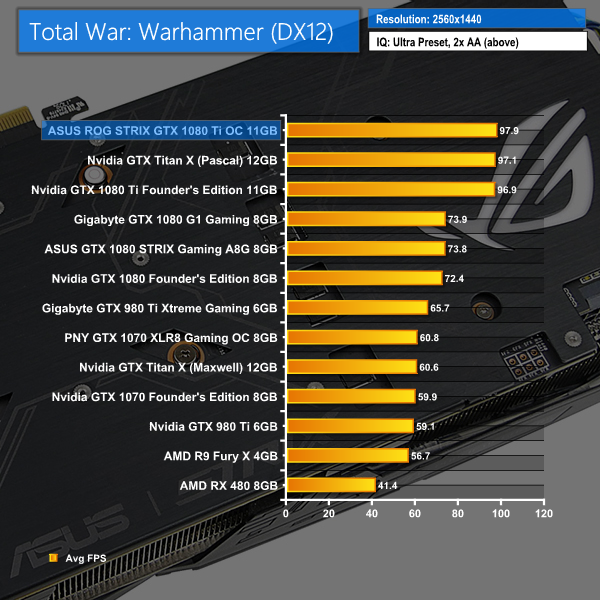
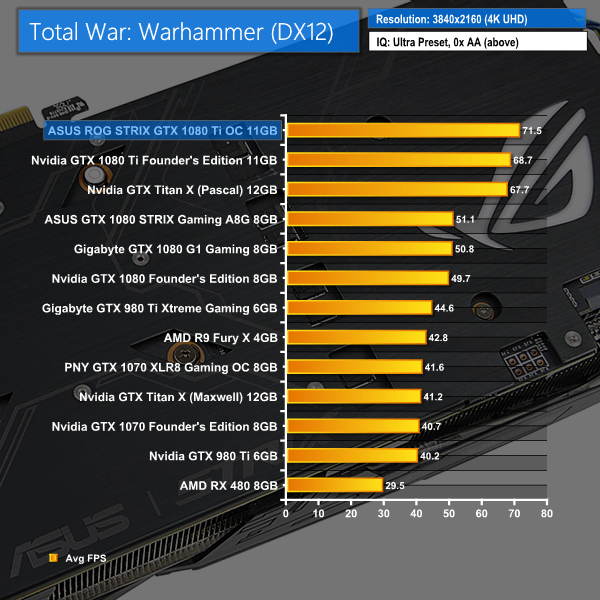
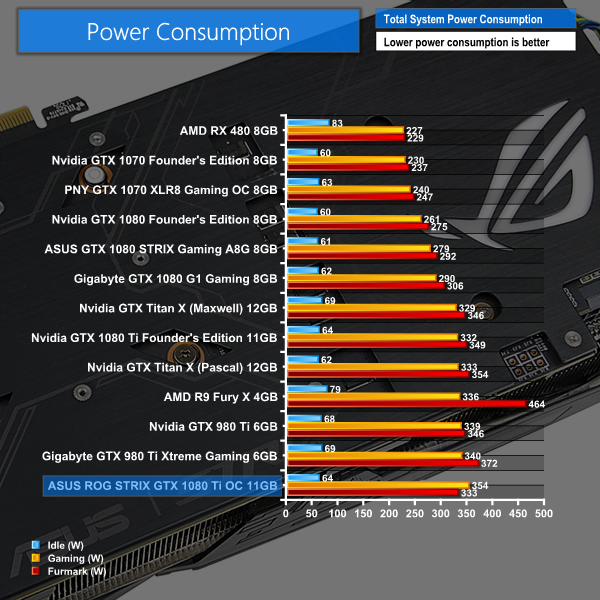
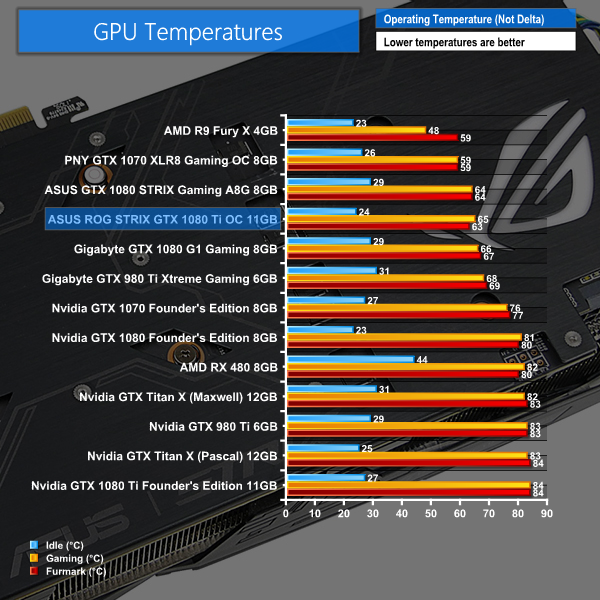


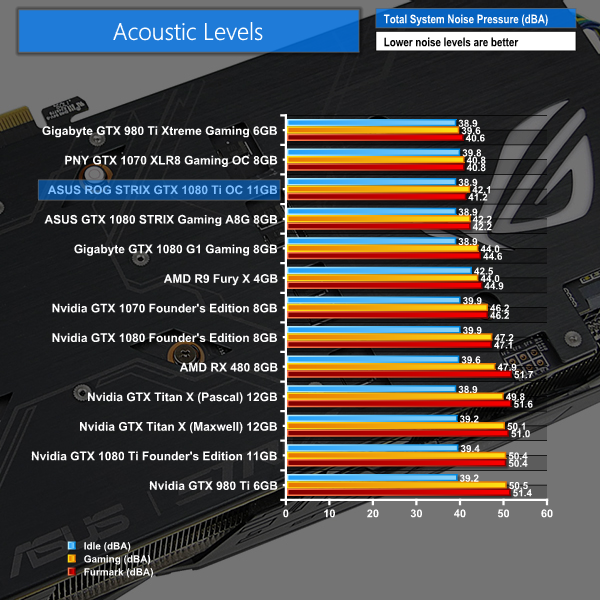
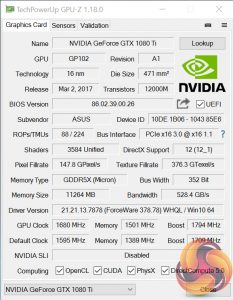
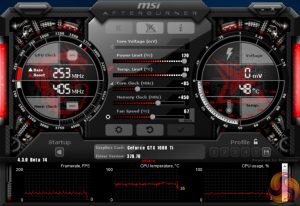
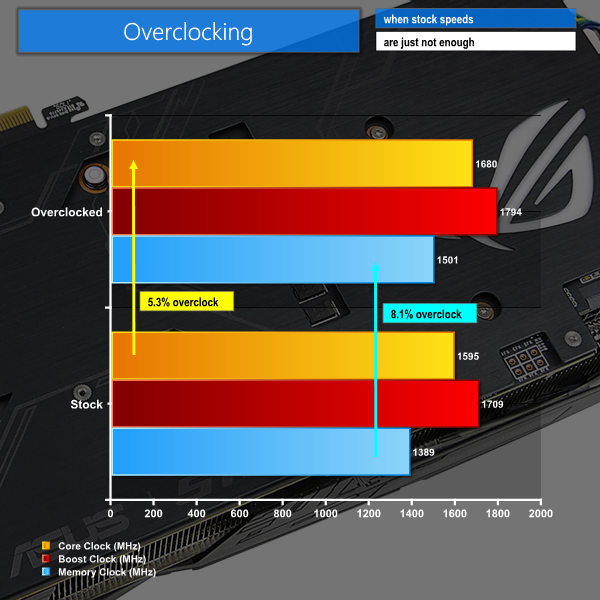
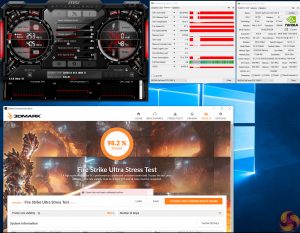

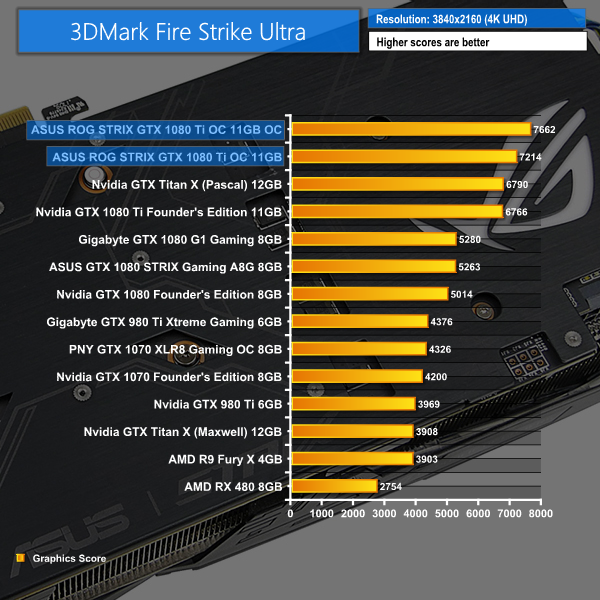
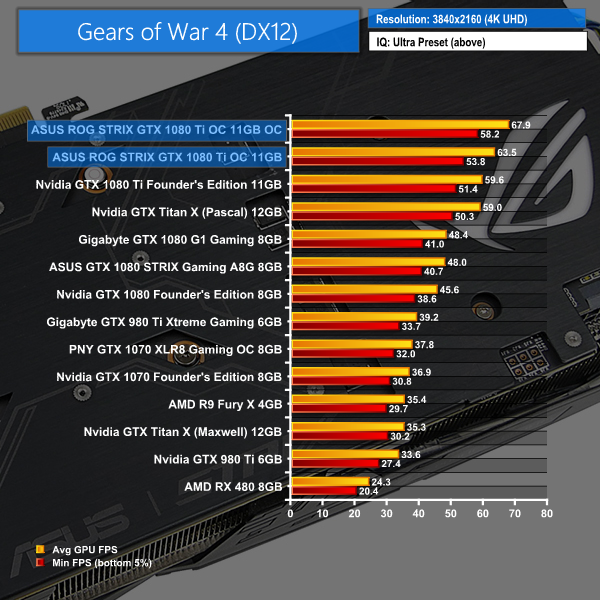
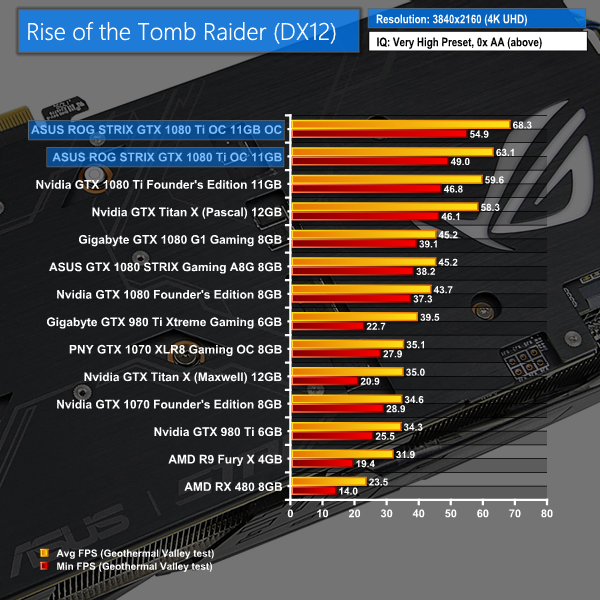
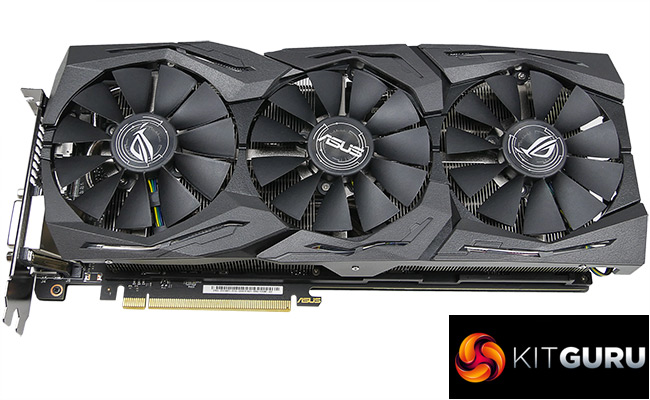



Yea, first come first serve, no I got no time for evga’s bs
Good review gents……..; impressive by any measure. Maybe next lifetime i will be able to afford/justify such a purchase; alternatively, after 5+ years when this level of power becomes mainstream!!!
Won’t be cancelling my pre-order after this review – hyped!
what happened with evga?
They took too long.
Are there any custom GTX1080 ti’s even available yet in the UK? This Asus one shows Preorder still on most etailers…..
great card, been watching for this one for a while. preordered it on the basis of this excellent review. thanks.
So how were the temps after OC? What RPMs did the fans reach under load? (after OC)?
Was it loud like turbo jet engine or manageable?
Anyone know where preorders are available in the us, im only seeing them available to preorder overseas at ridiculous prices :l
I’m in NL and I managed to pre-order, but I think so, they said late march and early April blah blah..could be able but you should check Hardware info for easy navigation, they show everything from all shops around you.
I ran a custom fan speed of 67% during the OC tests, which was overkill, but wasn’t as unbearable as I thought it would be in terms of noise output. This kept temperatures below 60C in our relatively short GoW4, ROTTR, and 3DM FSU benchmark runs, with the card boosting to 2050MHz core. Fan RPM at 67% was around 2450 RPM. You could definitely decrease the fan speed to a quieter level but it will depend on your preference for noise output, acceptable GPU temperature, and maximum GPU boost clock.
The stock-clocked default fan speed tended to sit around 37% under heavy gaming load with the GPU temp being around mid-60s. This was around 1320 RPM and was noticeably quieter than an AIO cooler managing the CPU (the noise readings for this fan speed are in the noise chart).
thx for the nice review. just curious. was this tested in an open test unit or was it inside a case.. if yes, which case?
My god I need this, the 3rd party ones are taking too long to be releases!!!!
I did expect this card to have more ram and to be at least 50% faster than 1080. I’m not sure if I should upgrade from my Asus GTX 780 TI or wait for the next generation. Currently I am able to play all good game on high settings. Of course I have windows 7 which means no directX 12 features. What do you guys think?
I think you’re an idiot.
I don’t really see the plastic shroud as an issue. I have the same thing on my Strix 1080 and it never bothered me. On a card this large I actually prefer plastic like this to something more robust, as the card is heavy enough as it is, and once I have it in the the case it’s not like the plastic is going to break on its own.
Hi.
This was tested inside an NZXT Phantom 630 case with the fans set to medium speed on its built-in controller. A Corsair H110i GT was mounted in the roof as exhaust.
Europe prices are with VAT…
Example from my preorder in Czech Republic €877 = $946 (Including VAT 21%)
Without VAT it’s €724 = $782
I wont be as harsh as Shaun Barclay, but it’s definitely time to switch to Windows 10 man. Windows 7 came out over 8 years ago. You are hamstringing yourself by holding onto it. Windows 10 is finally trouble free for all intents and purposes and has all the features of Win 7 in addition to many it will never have. And what could you possibly need more VRAM for? I have an MSI GTX 1080 Gaming Z and I never use all my 8GB. The 11GB on the 1080 Ti is plenty for anything right now. By the time you need more than that – the card will be older than your aging 780 Ti. I could definitely see that 780 Ti running out of memory though with that paltry 3GB. Can’t say if you could handle this card as an upgrade though without knowing your CPU. If your CPU is as old as the 780 Ti we could be talking bottleneck territory.
“1389MHz (11.1Gbps effective) memory.” I think you’re missing a digit on that memory clock.
How ddi you get the 28k FireStrike score for FE with 6700K? the highest recored now on 3dMark for that combo is around 23K!!!
Our chart displays the graphics score. The overall system score is shown in the screenshots (and is slower than the highest recorded combo on 3DMark’s website).
preordered from UK.
The terminology I was using was confusing so I have changed it. Thanks for pointing it out.
My Galax 1080 Ti FE winning my a small margin vs your unigine valley. 🙂
My Galax 1080Ti FE winning by a slight margin vs the Strix in Unigine. 🙂
https://uploads.disquscdn.com/images/ba314741d919e97795dad64fdd7614d6aae058d6ac7f2881d0417f384b7510c2.jpg
Without knowing? You call me an idiot without knowing who I am? Thank you for telling me that you’re an orphan. I feel sorry for you.
why would you test heaven with tessellation off… please test with all options MAXED OUT, I would LOVE to have these results..
People like Shaun Barclay have a flat head and don’t really walk with the reality. It’s like day dreaming, that is what people like Shaun Barclay sound like.
I have good CPU it’s the Core i7-5930K and have 16GB of ram.
Some of the games I use, are having problems with windows 10. I did try windows 10 and it really isn’t a gaming operation system.
So many useless apps running in the back and slowing down the operation system. The other thing is that Windows 7 is more gaming friendly.
I did try all and so far windows 7 does run better than windows 10. I have one pc for games and one laptop for online stuff. On my laptop I run the windows 10.
Maybe I wait till this card gets better cooling fans. My GTX 780 TI has two fans made by asus. It’s the Matrix version.
With that processor you’ll have no issue with a bottleneck. The 1080 Ti would be a great card -you’d be set for years.
In regard to Windows 7 – I get what you’re saying. I absolutely loved Windows 7, and it was a great OS. WAS…. The ironic thing is this: I was a Windows 7 fanatic (after being an XP fanatic), and I literally hated Win 10 at it’s launch. I completely skipped 8 and 8.1, Windows 7 was for me. But my next door neighbor and close friend is in the IT field and he is the one who converted me. He told me how much more efficient Win 10 runs at the kernel level, and it’s just a better overall built OS (which it owes a lot to Win 7 for that). He was right. And as far as any apps running in the background? Which ones? Because you can configure and turn off any apps you don’t need. I have Cortana disabled, and have no apps running except for the very few I want. OK I’m sorry, I’ll get off my soapbox now, but seriously you really are missing out sticking with Win 7, and not to mention MS is going to pull all support for it in the near future. And as far as Win 7 being more gaming friendly? Uh I really don’t think it is. They are essentially the same with the added bonus of Win 10 has of supporting DX12. But hey – no harm no foul -it’s your choice. You have a great set-up, I would consider the 1080 Ti!
I hate the way those charts are laid out, it makes it look like the perfectly serviceable AMD RX480 is a bad card to the untrained eye, if you take a closer look at 1080p which the majority of people are still gaming at you can see at Ultra Quality in GOW4 and TW3 it’s minimum frame rate is 60fps and the rest of the games are averaging the same. Comparing a £150 card with an £800 card just doesn’t make a lot of sense……..Unless that £800 card is 5x better lol
That is why I am confused. I think I will take it but not for now. Don’t like the first version with one fan on the corner. Overheats like hell.
I have been building up many computers. Been with computers since Windows 98 SE.
Yes, windows 10 is smarter and more professional but it does have issues with games. I find it very bad from Microsoft to add all the useless apps that it has build in. I don’t need a map build in the windows, I don’t need skype build in the windows. Yes, you can remove them or disable them but that is very useless.
I waste 30 to 45 minutes removing the rubbish software Microsoft has build in the windows. I have friends who ask me to clean the windows. Yes, that is what they say when it comes to remove the crap softwares windows has added.
Windows 8.1 was not bad for me. Used it for 8 months.
8/10 setups while installing windows 10, I get PC freezing when I disable Windows Defender. Just imagine, I have to manually disable windows defender via gpedit.msc and also disable sending data to microsoft via regedit Plus windows update has to be disabled via Services.msc.
Now tell me which brain did create Windows 10 and did not think to add these options to disable these things in a normal way?
Windows 7 on the other hand has things simple and directX 11 is really good. This means I can play games very well and fast.
Windows 8/8.1 and 10 are more for touch screens.
I have tried really hard to understand why Microsoft has created these 3 windows like this but I could not understand it.
I hope next windows is a Personal windows and not a shop windows.
Who needs contana anyway? If you don’t know your pc you should drive a tractor.
For now, I will play games on windows 7 and use windows 10 for online stuff.
How is the backplate a con? GPU’s don’t have much heat going out that way so any cooling backplates are just bogus anyway.
I’m actually in the same position you are. Also have the Asus 780ti OC Edition and will be getting the 1080ti. It still performs well on 1080p but I need the boost. I’ve upgraded to 1440p so I think the added performance will come in handy. Not sure what that other guy is referencing there though. I’d go ahead and get one. You’ve waited enough.
Pfft 1440p no thanks. 4k for over 2 years now here.
Just hate the lack of 1080 ti logo anywhere on the card. If I’m paying over $700 for one I want people to know which one it is. Looks like its the EVGA FTW 3 1080ti for me then.
Got over 154fps easy:
[img]http://i.imgur.com/OdYrOhY.jpg[/img]
http://i.imgur.com/OdYrOhY.jpg
Msi founders edition (air cooled ) with and old 4930k and ddr3 memos i smoke that asus
4k or nothing.
msi founders edition oc air cooled
http://i.imgur.com/OdYrOhY.jpg
Ahh okay. Well I am gaming on 1080P on an Asus monitor with 120Hz refresh rate. I’m going for 144hz but will still play on 1080p. 24 inch monitor for games is fine.
Just don’t buy the first edition. Wait for the card that have better cooling.
Got this from new and has never had any issues.
https://www.asus.com/ROG-Republic-Of-Gamers/ROG_MATRIXGTX780TIP3GD5/
Good luck buying the new one.
Doubt most people will care….lol
What a bunch of misinformation.. “noticeably better than what we achieved with the Founder’s Edition
board. This seems to be a direct result of the improved power delivery”
“the voltage limit as the general reason for ASUS’ ROG STRIX GTX 1080 Ti sitting at 2050MHz core frequency”
Do you follow hardware at all or understand how it works? Or do you just bench your products once and go back to sleep? This is not kepler… All these cards perform exactly the same on ambient cooling.
Cool. What OC presets where you using?
It’s not misinformation as we showed in our review of the Founder’s
Edition that its core clock in our testing would not boost as high as
2050MHz when overclocked. Its operating clocks when overclocked and
running 4K games, such as ROTTR, sat in the mid-1900MHz range.
Monitoring tools suggest that a power-induced limitation is why it
doesn’t boost further. This level of core clock speed has also been
reported by other publications, in case you think we are ‘misinforming’
you.
In our testing, the ASUS card would hold a stable 2050MHz core clock. The Founder’s Edition would not. I notice your quote also truncated part of my sentence that references ASUS’ superior cooler as part of the reason for higher boost clocks.
Dude with all due respect, 780ti is a sack of shit compared to the 1080ti…it is a sack of shit compared to my 980ti…I do not want to be rude, but you sound absolutely ludicrous. You seem to be content with the performance of the 780 ti which has ONLY 3 gbs of vram(laughable) and you’re complaining over the fact that 1080ti has 11 GBs of the same?? Thus, according to you getting more than 3 times the vram isn’t a justifiable reason for an upgrade? How much do you want? 1 terabyte?? For all intents and purposes, the 1080ti is an amazing gpu..your 780ti is nowhere in the ballpark buddy…its way outdated ..its your choice if you do not want to upgrade or not but stating that 1080ti wouldn’t be a noticeable upgrade over the outdated 780 ti is nothing short of blatant ignorance.
Even more ridiculous.
Good luck waiting.
Now do the same again without an aggressive fan curve.
Question is not if I want it or not. The question is why not add more ram to it and also making it 50% faster than the 1080. I am considering it but I have a feeling that the new generation might be better. I am gaming on 1080p and all games I am running, are at high or very high settings. I’m tired of replying to people who don’t understand me. I’m stopping.
Hey @disqus_XQ5oOgm5Ks:disqus. Do you think that the other NF Cards will have a much higher performance and better OC’s then the Strix? I’m getting the 1080ti soon and am having a hell of time deciding which one I should go for. I’m on a bit of a timeline as well, so any help will; be much appreciated.
You mean wait for the OC edition?
No, I mean the next generation. Maybe 1090 or other names nvidia might come up with. Most likely I will buy one of these in June. Let’s see how much money I can save. I don’t smoke or drink, I guess that will help collect more cash. ?
Ah, ok. I was like wait what? There’s a faster version coming out? And you’ve got a lot more patience than me my friend. Good luck.
man you do some bitching in the comments. The graphs look fine to me. If you use your head im PRETTY SURE they aren’t directly comparing some cards head to head, its called a cross section of hardware from all price ranges to show how the specific card they are reviewing fits into the marketplace. I wouldn’t feel too bad about buying the RX480, its still ‘perfectly serviceable’ as you say, if just a bit shit.
I can’t believe reading these comments how many people use Unigine Heaven as a viable indicator of game performance. Its a POS.
Im one of life’s eternal pessimists lol. Nah I’m just trying to spark up some debate, to be fair if I didn’t say something in half of these topics they would remain empty. If Kitguru ever asked me to stop I would, it wouldn’t bother me either way. Or I could just post really positive stuff.
Is this score with Strix being pushed more with OC or standard.
my light OC on FE is:
http://www.3dmark.com/fs/12136836
Was the OC they got to at around 2000 used when they were doing the benchmarks?
Can someone answer a question for me? There’s a review of the MSI 1080ti here (http://www.guru3d.com/articles_pages/msi_gtx_1080_ti_gaming_x_review,30.html). I can tell the Asus got a slightly higher core boost clock with Luke’s OC, but (sorry for my stupidity) which one had a better memory OC? I’m seeing different numbers everywhere here and am thoroughly confused.
Why wait to upgrade when the 1080 Ti is orders of magnitude faster/more powerful than the card you currently have?
Awesome thanks!
144hz 1440p or nothing, 4k is pathetic considering it can hardly get 60 fps without turning almost everything off.
The reason you were called an idiot is because you don’t know what you’re talking about at all but you try to sound like you do, so unfortunately you kinda sound like an idiot.
I had a 780 TI and upgraded to the 1080 TI. I skipped the 900 series generation, as I paid $700 for this 780 TI when it was the top of the line card. The 1080TI is the same price now, and it is well worth the upgrade. Your question of whether you should wait for the next gen? The answer is no, you already did that, assuming you have the budget.
They didn’t add more ram to it because there isn’t enough space on the PCB past 12 GB, they needed to distinguish it from the Titan, and because it simply doesn’t need it for video games AT ALL. There is not a single game that uses 11 GB of VRAM.
Your fantasy world where the 1080 TI edition released LESS THAN A YEAR after the 1080 (10 months) with a 50% performance increase is amusing. No single TI edition has ever been as much of an upgrade from the non TI edition as this current generation. I believe I read it was a ~25-30% increase in performance over the 1080. Thats HUGE. For a card released at the exact same price point and only 10 months later, its amazing.
Not gonna dive into too much about Operating systems. Much like the nonsense you talk about GPUs, it seems like you take minor things you may have read on the internet and mix them in with your feelings about how you don’t like the work involved. It takes a little time to optimize your OS or simply disable some apps/background tasks, so what? You have to do in every version of windows that I’ve ever used.
Simply put, the 1080TI is a great upgrade over a 780 TI, but for 1080p gaming its a bit overkill. I recommend upgrading to 2K (1440P) 27″, but to each their own.
Why on earth would you type all that to an idiot? You consider me an idiot and yet you type so much? Those days it’s more easy to offend rather than understand?
I am surprised how rude and disrespectful people have become.
Actually, I said “unfortunately you kinda sound like an idiot”.
I typed as much hoping it would help educate you, because your expectations were both unrealistic and ignorant of the technology itself not to mention the business side of this industry.
I’m surprised at how easily offended people have become, especially after they spout nonsense on the internet. 🙂
what I said about technology has no offensive language for nobody. I spoke my opinion which is based on things I experienced for the pas 18 years. If I can remember, I have been building computers almost every week. I bought parts online and build them according to people’s wishes.
Calling me this and that why I say something I experienced is really not polite. It tells me that your environment you were born and grew up is really miserable. You don’t think or can’t think properly to understand what I say. That’s why you end it up with a word that describes your whole personality.
I find it sad how companies make money out of us. I am not saying they should make things for free. I am happy to pay for things I enjoy but not 300 to 500 percent.
Anyway, you have a good day or night wherever you are.
Pffft 60hz no thanks. 144hz for over 2 years now here.
Pfffft 144hz no thanks. 165hz for over 2 years now here.
Haha I actually do have the PG279Q but didn’t want to sound too much like a tit and say 165hz! Just waiting for the guy with that 240hz monitor to drop in 🙂
Pfft 240hz no thanks. 60hz for over 0 years now here. ;(
Wrong… Many Youtubers, for example GamersNexus had throughout testing of these cards and when they used watercooling on Founders Edition they got nearly exactly the same results as with any aftermarket cooling ones. Its all about the thermals.
For the same extra you pay for custom card over founders you can buy watercooling kit for FE and its better again…
“Superb overclocking potential” yet my FE reaches 2050MHz as well… lmao also Gigabyte Aorus Xtreme Edition comes out faster out of the box than the max OC you were able to get out of that Asus card and it costs the same LOL!
MY card goes +650 OC memory..
https://www.youtube.com/watch?v=pwrPrm0XcD8
I sure hope this iteration of their STRIX cards is better than the experience I had with their last ones in terms of quality control. Out of 4 STRIX cards with heavy usage (2x390X STRIX and 2x980Ti STRIX); 2 had a fan go bad and 1 had unbelievably excruciating coil whine. So 3/4 RMA for that set.
Windows 10 is exactly gaming in mind built OS. Much more so than Windows 7..
Windows 10 has no issues with games… Do your research fool.
He typed all that to handhold you. You are a stubborn idiot it’s just a fact bro.
Can i conductonaut on this 1080ti ?????
What is the point of comparing them then, if you need to add stuff to the other one to achieve the same results, dumbass..?
yes, and have extra components in your case for what? To achieve the same as without then? Man you’re a dumbass…
“when they used watercooling” ashdjauwyh i’m gonna jump out this window right here okay?
Well PG279Q doesn’t go to 165 😀 the PG278QR does. Pff 240hz here, not that it’s possible to play 1440p with 244hz but fuck you all xD
PG279Q absolutely goes to 165hz, I have one.